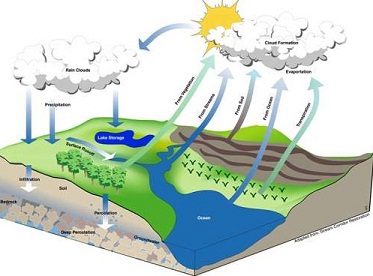History And Origin of Hydrology
It was along the Indus in Pakistan, the Tigris and Euphrates in Mesopotamia, the Hwang Ho in China, and the Nile in Egypt that the first hydraulic engineers created canals, levees, dams, subsurface water conduits, and wells as early as 5000-6000 years ago. Advances in the 18th century included the Bernoulli piezometer and Bernoulli's equation, by Daniel Bernoulli, the Pitot tube. The 19th century saw development in groundwater hydrology, including Darcy's law, the Dupuit-Thiem well formula, and Hagen-Poiseuille's capillary flow equation.
Jacqui (1987) traced the history of hydrology to ancient China and postulated three stages of the development of the study of hydrology.
- Stage of geographical hydrology
- Stage of engineering hydrology
- Stage of social development
Stages in the History and origin of Hydrology
1. Stage of geographical hydrology
Establishment of hydrological cycle and concept of water balance
2. Stage of engineering hydrology
Design of control structures and quantitative analysis of hydrological phenomena.
3. Stage of social development
It is the stage in which the water demand is more and large scale of use of water resources is occurring. Coupled with the development of new techniques brought about a new stage of water resources involving resource analysis and management.
Development of hydrology according to history
-
In Egypt, the Nile floods formed basis for a large scale successful agricultural system. Irrigation's history can be traced back as up to 5000 years, the proof of which is the remains of the world's oldest dam built between 2950 and 2750 B.C found near Cairo. (Biswar 1970).
-
In nearly 3000 B.C gauges were installed to measure flow of Nile.
-
The next stage is when Aristotle (384-322 B.C) explained mechanism of precipitation.
-
Then da Vinci (1452-1519) gave the better understanding of flow in open channels.
-
Palissy (1510-1590) stated that rainfall was the only source of water of spring and rivers
-
Da Vinci and Palissy gave the concept of water cycle in the 15th century.
-
Modern science of hydrology began with studies of Perrault, Marriot and Hally in the 17th century.
-
Perrault presented the concept of rainfall measurement by knowing the drainage area, using water balance technique.
-
Holly measured evaporation of Mediterranean Sea.
-
16th century brought numerous advances in hydraulic theory and instrumentation. Piezometer, Pitot tube, Bernoulli's theory and Chezy formulae are some example examples.
-
In 19th century significant advances were made in ground water hydrology and in measurement of surface water. Capillary flow equation? Darcy's Law and Depiut theorem evolved during this etc.



